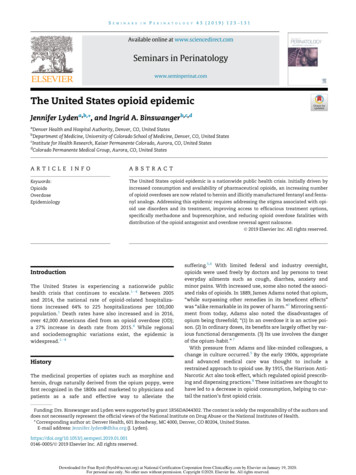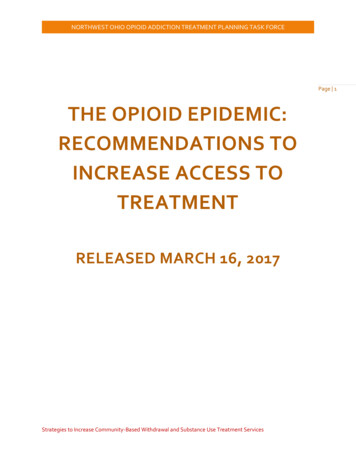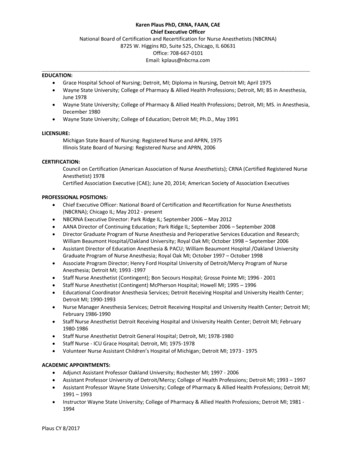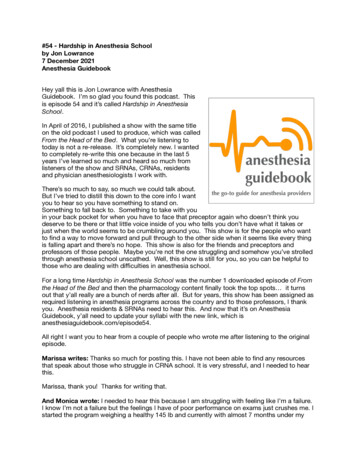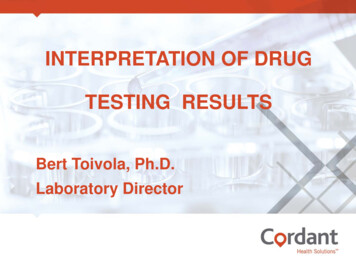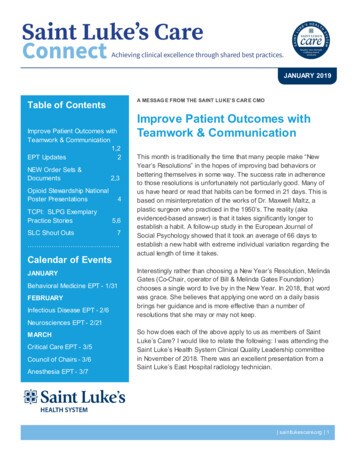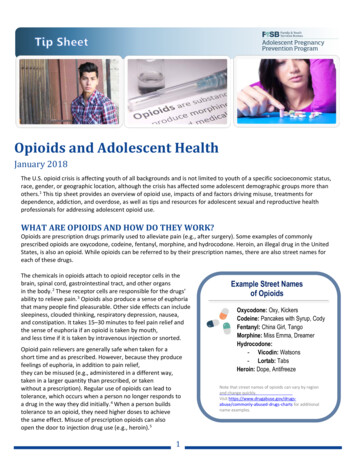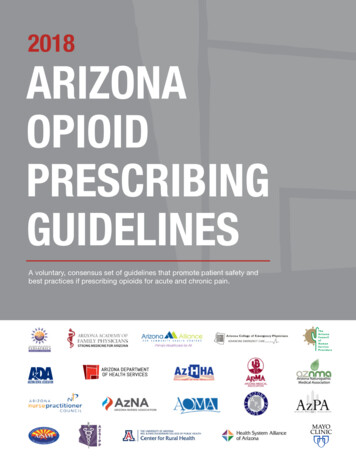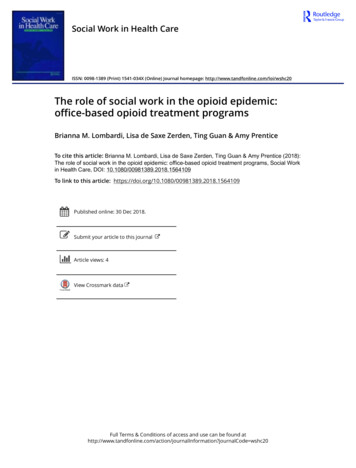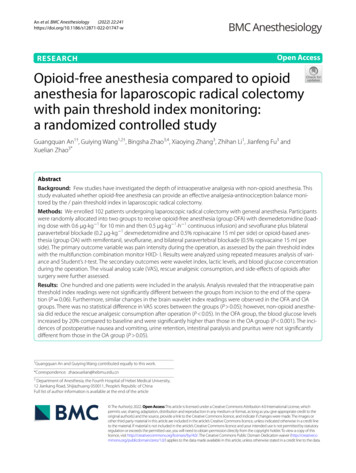
Transcription
(2022) 22:241An et al. BMC 1747-wOpen AccessRESEARCHOpioid‑free anesthesia compared to opioidanesthesia for laparoscopic radical colectomywith pain threshold index monitoring:a randomized controlled studyGuangquan An1†, Guiying Wang1,2†, Bingsha Zhao3,4, Xiaoying Zhang3, Zhihan Li1, Jianfeng Fu3 andXuelian Zhao3*AbstractBackground: Few studies have investigated the depth of intraoperative analgesia with non-opioid anesthesia. Thisstudy evaluated whether opioid-free anesthesia can provide an effective analgesia-antinociception balance monitored by the / pain threshold index in laparoscopic radical colectomy.Methods: We enrolled 102 patients undergoing laparoscopic radical colectomy with general anesthesia. Participantswere randomly allocated into two groups to receive opioid-free anesthesia (group OFA) with dexmedetomidine (loading dose with 0.6 μg·kg 1 for 10 min and then 0.5 μg·kg 1·h 1 continuous infusion) and sevoflurane plus bilateralparavertebral blockade (0.2 μg·kg 1 dexmedetomidine and 0.5% ropivacaine 15 ml per side) or opioid-based anesthesia (group OA) with remifentanil, sevoflurane, and bilateral paravertebral blockade (0.5% ropivacaine 15 ml perside). The primary outcome variable was pain intensity during the operation, as assessed by the pain threshold indexwith the multifunction combination monitor HXD- I. Results were analyzed using repeated measures analysis of variance and Student’s t-test. The secondary outcomes were wavelet index, lactic levels, and blood glucose concentrationduring the operation. The visual analog scale (VAS), rescue analgesic consumption, and side-effects of opioids aftersurgery were further assessed.Results: One hundred and one patients were included in the analysis. Analysis revealed that the intraoperative painthreshold index readings were not significantly different between the groups from incision to the end of the operation (P 0.06). Furthermore, similar changes in the brain wavelet index readings were observed in the OFA and OAgroups. There was no statistical difference in VAS scores between the groups (P 0.05); however, non-opioid anesthesia did reduce the rescue analgesic consumption after operation (P 0.05). In the OFA group, the blood glucose levelsincreased by 20% compared to baseline and were significantly higher than those in the OA group (P 0.001). The incidences of postoperative nausea and vomiting, urine retention, intestinal paralysis and pruritus were not significantlydifferent from those in the OA group (P 0.05).†Guangquan An and Guiying Wang contributed equally to this work.*Correspondence: zhaoxuelian@hebmu.edu.cn3Department of Anesthesia, the Fourth Hospital of Hebei Medical University,12 Jiankang Road, Shijiazhuang 050011, People’s Republic of ChinaFull list of author information is available at the end of the article The Author(s) 2022. Open Access This article is licensed under a Creative Commons Attribution 4.0 International License, whichpermits use, sharing, adaptation, distribution and reproduction in any medium or format, as long as you give appropriate credit to theoriginal author(s) and the source, provide a link to the Creative Commons licence, and indicate if changes were made. The images orother third party material in this article are included in the article’s Creative Commons licence, unless indicated otherwise in a credit lineto the material. If material is not included in the article’s Creative Commons licence and your intended use is not permitted by statutoryregulation or exceeds the permitted use, you will need to obtain permission directly from the copyright holder. To view a copy of thislicence, visit http:// creat iveco mmons. org/ licen ses/ by/4. 0/. The Creative Commons Public Domain Dedication waiver (http:// creat iveco mmons. org/ publi cdoma in/ zero/1. 0/) applies to the data made available in this article, unless otherwise stated in a credit line to the data.
An et al. BMC Anesthesiology(2022) 22:241Page 2 of 10Conclusions: This study suggests that compared to the opioid anesthesia regimen, our opioid-free anesthesiaregimen achieved an equally effective intraoperative pain threshold index in laparoscopic radical colectomy. Theincidence of opioid-related adverse reactions was not different between regimens, and intraoperative blood glucoselevels were higher with opioid-free anesthesia.Trial registration: ChiCTR1900021223, 02/02/2019, Title: " Opioid-free anesthesia in laparoscopic surgery: a randomized controlled trial ". Website: hppts://www. chictr. ogr. cnKeywords: Analgesia, Anesthesia, Dexmedetomidine, Analgesics, Opioid, Pain Management, Colorectal surgery,Laparoscopy, Colorectal cancerBackgroundSeveral clinical studies have challenged the commonpractice of administering opioids during anesthesia, suggesting that opioid-free anesthesia (OFA) may effectivelyprovide adequate antinociception while hopefully reducing opioid-related side effects [1–5]. However, these studies focused more on the effect of OFA on postoperativeanalgesia scores (visual analog scale, VAS), rescue analgesic consumption, and incidence of adverse reactionsrelated to opioid analgesics. Few studies have assessedthe intraoperative depth of analgesia between nonopioid and opioid anesthesia. Under general anesthesia(GA), nociceptive signals are continuously generated andexert negative physiological consequences on unconscious patients. Inadequate intraoperative analgesia canincrease postoperative complications, leading to poorprognosis and prolonged hospital stay [6]. In our previous study, the depth of analgesia of OFA in video-assistedthoracic surgery was continuously monitored using thepain threshold index (PTI) to determine whether nonopioid anesthesia could provide adequate analgesia [7].The results showed that the OFA regimen could providean equally sufficient intraoperative analgesia-nociceptionbalance and lower depth of sedation with the waveletindex (WLI).Controversies remain regarding the implementation ofOFA, such as the optimal regimen, safety, and whetherpatients experience short and long-term benefits [6].Beleoil et al. reported that bradycardia requiring atropine was more frequent in the dexmedetomidine groupthan in the remifentanil group. Three of the five casesof profound bradycardia in the dexmedetomidine groupoccurred during carbon dioxide insufflation during laparoscopic surgery. The level of intraoperative opioid-sparing could differ among surgical procedures, and not allanalgesics may be safe in all procedures or patients. Following somatic, visceral and inflammatory componentswith pain originating from intestinal resection, abdominal insufflation and inflammation, laparoscopic radical colectomy (LRC) leads to peritoneal distention anddamage and causes great perioperative pain. Opioids arewidely used in LRC to provide effective analgesia and toinhibit sympathetic response. At present, few trials areinvestigating whether OFA, compared with traditionalopioid anesthesia (OA), can provide a safe and effectiveanalgesia-nociception balance with continuous PTI monitoring. We hypothesized that the use of OFA in patientsreceiving LRC could achieve the goals of analgesia, hypnosis, hemodynamic stability, and avoidance of opioidside effects.In this prospective, randomized trial we tested the primary hypothesis that our OFA regimen, compared totraditional OA, could allow an efficacious intraoperativeanalgesia-antinociception balance with PTI monitoring.We further compared the difference between non-opioidand opioid anesthesia in the postoperative recovery ofpatients undergoing LRC.MethodsThis was a randomized controlled and single-center clinical trial. The study protocol was approved by the ClinicalResearch Ethics Committee of the Hebei Medical University Fourth Hospital (#2,018,144; Chairperson Prof Guiying Wang) on Januray 20 2019. The study was registereda priori with the Chinese Clinical Trial Registry (www. chictr. org. cn, ChiCTR 1,900,021,223; on February 2 2019,principal investigator Xuelian Zhao). The eligible patientsigned a written informed consent form after obtainingthe consent of the participant.Participant eligibilityInclusion criteria: Patients with an American Societyof Anesthesiologists (ASA) physical status I or II, aged18—65 years who were scheduled for elective LRC forcolorectal cancer were recruited. The exclusion criteriawere as follows: allergy to any experimental drug or itsexcipients; patients with central nervous system diseases(such as epilepsy, cerebral infarction, or cerebral hemorrhage history); a history of psychiatric illness; hepatic orrenal impairment a history of chronic pain or alcohol ordrug abuse; patients who were pregnant or breastfeedingwomen; patients who were unable to understand the painassessment or use a patient-controlled analgesia (PCA)device; patients who were prescribed β-blockers and a
An et al. BMC Anesthesiology(2022) 22:241Page 3 of 10heart rate (HR) 50 bpm; and patients with body massindex (BMI) greater than 30 kg·m 2.Allocation and blindingPatients were randomly allocated to the opioid-freeanesthesia group (group OFA) or traditional opioidanesthesia group (group OA) using sealed opaque envelopes. The treatment arm was revealed on the morningof surgery. A computer-generated random allocationsequence was created by an independent investigatorusing Excel version 2016 (Microsoft), with 1:1 allocationand random block sizes. Participants, surgical staff, andpostoperative outcome assessors were blinded to groupallocation, whereas anesthesia providers who did notparticipate in the assessment of the patients at any timecould not be blinded to facilitate intraoperative anesthesia management.Ultrasound‑guided bilateral paravertebral block (PVB)Before the induction of GA, the patients in both groupsunderwent ultrasound-guided bilateral PVB in the proneposition using an ultrasound machine (Voluson i, GEUSA) and a high-frequency linear array probe. After theprobe was placed at the level of the T10 -11 interspace,the apex of the paravertebral space was visualized. An18G, 10 cm needle (Kangdelai, China) was inserted in thelateral-to-medial direction using an in-plane approachand advanced until the needle tip penetrated the internal intercostal membrane. The 15 ml mixed liquor (0.5%ropivacaine plus 0.2 μg·kg 1 dexmedetomidine in groupOFA; 0.5% ropivacaine in group OA) was subsequentlyinjected into the paravertebral space. The same procedure was repeated on the other side at T10—11. Sensoryblockade was tested using the pinprick method. Patientswere observed for adverse reactions associated with PVBover the next 15 min.Electroencephalogram (EEG) measurement methodAnesthetic management protocolAll patients underwent analgesia index (PTI) and sedation index (WLI) monitoring with a multifunctioncombination monitor HXD-I (Heilongjiang HuaxiangTechnology Co., Ltd., Heilongjiang, China) after enteringthe operating room (see the report by An et al. [7]).The PTI, a measure reflecting the antinociceptive stateunder general anesthesia, is based on EEG wavelet analysis ranging from 0 to 100. A PTI 40–60 is appropriatefor intraoperative analgesia with higher values indicatinga patient’s lower pain tolerance. The WLI ranging from0–100 shows the depth of sedation with changes in EEGsignals. WLI 35 over sedation; WLI 35–69 anesthesia,complete depression of consciousness; WLI 70–89 lightnarcosis/ sleep; WLI 90 awake states.The OFA and OA regimens were based on our previouslyreported approaches (Table 1) [7].Following PVB, patients in the OFA group received aninfusion of dexmedetomidine (0.6 μg·kg 1) and 0.5 mgatropine for 10 min, after which the infusion rate of dexmedetomidine was reduced to 0.5 μg·kg 1·h 1, terminating 60 min before the end of the surgery. All the patientsreceived ketorolac (30 mg) for GA induction. Before theend of the operation, the patients received an intravenousbolus of 0.25 mg palonosetron to prevent post-operativenausea and vomiting (PONV), and the central vein wasconnected to a PCA machine (6 μg·kg 1 dexmedetomidine and 180 mg ketorolac added to 100 ml of saline at2 ml·h 1 and the lock time was 15 min).Table 1 Time chart of anesthetic managementGroup PremedicationPre-GA inductionGA InductionGA MaintenanceGA RecoveryPCA (100 ml)GroupOFABPVBRopivacaine (0.5%)Dexmedetomidine(0.2 μg/kg)15 ml per sideDex (0.6 μg/kg,10 min)Dex (0.5 μg·kg 1·h 1,30 min)Dex (0.5 μg·kg 1·h 1)Ketorolac(30 mg)Propofol (2 mg/kg)Cisatracurium(0.2 mg/kg)Dex a(0.5 μg·kg 1·h 1)Sevoflurane b (1%-3%)Cisatracurium(2–4 mg per 30 min)Palonosetron0.25 mgNeostigmine (up to2 mg)Atropine (0.2–1 mg)Dex (6 μg/kg)Ketorolac (180 mg)GroupOABPVBRopivacaine (0.5%)15 ml per sideSufentanil (0.5 μg/kg)Propofol (2 mg/kg)Cisatracurium(0.2 mg/kg)Remifentanil b(200–500 μg/h)Sevoflurane b (1%-3%)Cisatracurium (2-4 mg per 30 min)Namefene [8,9] (0.05 mg)Palonosetron(0.25 mg)Neostigmine (up to2 mg)Atropine (0.2–1 mg)Dezocine (0.5 mg/kg)Ketorolac (180 mg)GA General anesthesia, BPVB Bilateral paravertebral blockade, Dex Dexmedetomidine, PCA Patient control analgesiaaInfusion was stopped 60 min before end of surgerybAt end of surgery, inhalation and infusion were terminated
An et al. BMC Anesthesiology(2022) 22:241Page 4 of 10In the OA group, 0.5 μg·kg 1 sufentanil was administered intravenously (IV) for GA induction. To maintainGA, remifentanil was continuously infused at a rate of4–10 μg·kg 1·h 1 and discontinued before skin closure.Before the end of the operation, the patient received0.25 mg palonosetron IV, and PCA (0.5 mg·kg 1 dezocineand 180 mg ketorolac added to 100 ml with normal salineat 2 ml·h 1 and the lock time was 15 min).Anesthesia induction was started 40 min after intravenous infusion of dexmedetomidine with 2 mg·kg 1propofol and cis-atracurium 0.2 mg·kg 1 IV in allpatients. Cis-atracurium (2- 4 mg every 30 min) andinhaled sevoflurane were administered to maintainanesthesia. Ventilation was controlled mechanicallyand adjusted to maintain the end-tidal C O2 value at30—40 mmHg throughout surgery with 50% oxygeninhalation. The intraoperative carbon dioxide pneumoperitoneum pressure setting was maintained at 12 cmH2O.Air heating blankets were placed on any exposed parts ofthe body to maintain body temperature. After the operation, tracheal extubation was determined by the anesthesiologist when the patient reached a regular spontaneousbreathing mode and WLI 90. Postoperative rescue analgesic flurbiprofen axetil was injected intravenously basedon the patient’s request.(MAP 60 mm Hg) was treated with norepinephrine.When the MAP was 20% of the baseline value beforeinduction, nitroglycerin was administered.The potassium concentration between the groups wasdeclared a secondary outcome in the trial registered onhttps:// www. chictr. org. cn. However, we did not recordintraoperative blood potassium values, because somepatients had hypokalemia before the operation andreceived intravenous infusion of potassium chloride.OutcomesAll statistical analyses were performed using the chisquare independence test or Fisher’s exact test to analyze categorical data. The unpaired Student’s t- testwas used to analyze the significance of the quantitativedata. The Wilcoxon rank-sum test was used if the datawere not normally distributed, as evaluated by the Shapiro–Wilk test. Descriptive parameters were expressedas mean values (SD). Highly skewed quantitative dataare expressed as median interquartile range (IQR) withinterquartile range.The mean PTI readings at different time pointswere compared using an unpaired Student’s t-test andrepeated-measures analysis of variance between the twogroups. One-way analysis of variance was used to compare the mean PTI readings at each time point to themean PTI at baseline within the OFA and OA groupsusing Dunnett’s multiple comparison test. Repeatedmeasures analysis of variance, Student’s t-test, and oneway analysis of variance with Dunnett’s multiple comparison test were used to compare WLI, MAP, HR and SpO2 at seven-time points, and pH, the pressure of carbon dioxide (PaCO2), lactic acid levels, and blood glucose concentration at six-time points within and betweengroups. The mean VAS scores between the two groupswere compared using the Mann–Whitney U test. Statistical significance was set at P 0.05. All statistical analyseswere performed using SPSS 17.0.The primary outcome of this study was the intraoperative PTI readings recorded at after entering the operating room (T0, baseline value), before GA induction(T1), after intubation (T2), after incision (T3), 5 minafter carbon dioxide pneumoperitoneum (T4), at theend of the operation (T5), and 5 min after extubationin the operation room (T6). Intraoperative secondaryoutcomes included WLI reading, mean arterial pressure (MAP), HR, pulse oxygen saturation (SpO2) at thesame time points as when PTI was recorded, potential ofhydrogen (pH), partial pressure of carbon dioxide, bloodglucose concentration and lactic acid level from intraoperative blood gas after entering the operating room (G0,baseline value), before GA induction (G1), 1 h after surgery begun (G2), 2 h after surgery begun (G3), 3 h aftersurgery begun (G4), and 5 min after extubation in theoperation room (G5). The total anesthetic consumption,extubation time, fluid infusion volume, and urine volume were measured and recorded. Postoperative secondary outcomes included VAS scores at 24 h, 48 h and72 h after operation, time to flatus, PONV, length of stayand hospitalization cost. Intraoperative adverse events,including bradycardia, hypotension, and hypertension,and postoperative adverse events were recorded. Bradycardia was defined as a heart rate of 45 bpm and wastreated with intravenous atropine (0.5 mg). HypotensionSample size calculationThe mean PTI at 5 min after pneumoperitoneum during the operation was 55.4 (7.3), as calculated in a previous pilot study of 15 patients with OA who underwentLRC. Therefore, we assumed that OFA could achievean equal PTI. With a significance level of 0.05, a powerof 0.85, upper equivalence limit of 5, lower equivalencelimit of 15, true difference of 1 and standard deviation(SD) of 7, we calculated that each group should include39 patients per group (PASS 11). Considering a loss- tofollow-up rate of approximately 20%, we needed to enroll47 patients per group.Statistical analysis
An et al. BMC Anesthesiology(2022) 22:241Page 5 of 10Fig. 1 Study flow diagram. * Reasons for exclusion from the analysis: Group OA: 1-converted to open surgeryResultsFrom February 2019 to November 2019, a total of 273patients were included for eligibility assessment. In theend, 102 patients were selected for this clinical investigation. The two groups are comparable (Fig. 1). In the OAgroup, 1 case was converted to open operation, and 101cases were suitable for analysis (Fig. 1). The groups weresimilar at baseline (Table 2).PTI readings, WLI readings, MAP, HR, S pO2, pH, PaCO2, lactic acid levels and blood glucose concentrations of two groups showed significant changes at different time points with single factor (time) repeatedmeasurement analysis (P 0.001). The results from multiple factors repeated measurement analysis of varianceshowed that PTI readings, MAP, S pO2, pH, P aCO2, lactic acid levels were not significantly different betweenthe two anesthesia methods, while WLI readings, HRand blood glucose values were statistically significantbetween the two groups (P 0.001).PTI readings and WLI readings in group OFA at T1and T2 were significantly lower than those in group OA(P 0.05, Fig. 2). The pH, lactic value at G1 in groupOFA were lower than those in group OA (P 0.05,Fig. 3). At G1, P aCO2 value in group OFA was significantly higher than that in group OA (P 0.001, Fig. 3).The visual analogue scale (VAS) scores at rest and oncoughing between groups were not significantly different at 24 h, 48 h and 72 h after operation (P 0.05,Table 3). The rescue analgesic consumption in the OFAgroup significantly decreased at 24 h and 72 h afteroperation (P 0.05, Table 3).The mean extubation time were significantly longerin group OFA (P 0.001). There were not significantlydifferent in urinary retention, pruritus, PONV, time topassage of flatus, hospital discharge time and hospitalexpenses between two groups. There was no local infection or hematoma at the puncture site 24 h after theoperation. No patient died, was transferred to ICU andrespiratory dysfunction, and no patient was intubatedagain after the tracheal intubation was removed. Onecase of atrial fibrillation (amiodarone treatment) andone case of hypotension (blood transfusion treatment)occurred in both the OFA group and the OA group. Nopatients in group OFA developed hypoxia (SpO2 90%)or bradycardia requiring treatment.
An et al. BMC Anesthesiology(2022) 22:241Page 6 of 10Table 2 Patients characteristics and perioperative outcome variablesGroup OAn 50Group OFAn 51StD / PMale (n, %)22.0 (44.0)28.0 (54.9)0.109¶Age (SD)52.5 (10.2)53.1 (8.6)0.058¶Body Mass Index (BMI, SD)24.6 (2.9)24.4 (3.1)0.071¶Duration of surgery (SD, min)196.3 (51.5)205.1 (48.4)0.375§154.5 (37.1)-Dexmedetomidine infusion time (SD, min)Remifentanil infusion time (SD, min)192.3 (51.8)Fluid Infusion volumes (IQR, ml)1900.0 (1500.0.0–2445)2000.0 (1800.0–2245.0)0.264*Urinary volume (IQR, ml)550.0 (400.0–750.0)600.0 (360.0–800.0)0.659*Dexmedetomidine consumption (SD, µ g)—125.0 (33.0)Remifentanil consumption (SD, mg)1.1 (0.4)—Atropine consumption (IQR, mg)0.9 (0.8–1.0)1.0 (0.8–1.1)0.028*Norepinephrine consumption (IQR, µ g)28.0 (0–160.0)6.0 (0–65.0)0.368*Extubation time (SD, min)10.9 (3.6)15.0 (6.8) 0.001§Urinary retention (n, %)1 (2)00.310#Pruritus (n, %)00-Postoperative nausea and vomiting (n, %)2 (4)0 (0)0.149#Bedtime (SD, h)46.4 (11.5)49.2 (11.1)0.274§Drinking time (SD, h)46.2 (16.4)44.4 (17)0.593§Time to passage of flatus (SD, h)34.7 (18.6)32.3 (19.9)0.547§Hospital discharge time (SD, day)8.5 (2.9)8.9 (2.8)0.440§Hospital expenses (SD, thousand Yuan)80.4 (14.4)78.6 (15.1)0.535§Data are presented as relative number of patients, mean standard deviation (SD), median (IQR)¶Standardized differences were calculated using Cohen d (JASP); * Wilcoxon rank-sum test; # Fisher’s exact test; § unpaired Student’s t-testSD Standardized differences; Extubation time: time from the completion of intravenous neostigmine and/or nalmefene to the removal of the tracheal tube;Time to passage of flatus: the time from returning to the ward to the first breaking wind. Dexmedetomidine infusion time: the time from giving loading dosedexmedetomidine to stopping input. Remifentanil infusion time: the time from infusion remifentanil to stopping inputDiscussionThe results of this randomized, prospective study indicated that compared to opioid-based anesthesia, ourOFA regimen with bilateral PVB in patients undergoingLRC could provide equally adequate analgesia and antinociception effects during operation, with better antinociception to intubation stimulation in patients (ASA I-II,18–65 years old, BMI 30 kg·m 2), guided by PTI monitoring. Non-opioid anesthesia can reduce the number ofemergency analgesics at 24 h and 72 h after surgery, butthere was no difference in VAS scores between the twogroups after surgery. In addition, postoperative adversereactions related to opioids in the OFA group, includingPONV, urine retention, intestinal paralysis and pruritus, were not significantly different from those in the OAgroup.The goal of providing OFA has been made possible by multimodal analgesia, based on the synergisticuse of drugs with different modes of action, leading toadditive pain management that works at different nociceptors along the pain pathway [10]. Continuous infusion of dexmedetomidine, inhalation of sevoflurane,intravenous bolus ketorolac and single-shot bilateralPVB (a mixture of bupivacaine and dexmedetomidine)were used to replaceOA in our study. PTI has emergedas a new method to monitor nociception and analgesiain unconscious patients [11–13]. Our results indicatedthat the PTI readings of group OFA were similar to thoseof group OA at the incision, 5 min after pneumoperitoneum, and at the end of the operation and were effectively maintained in the optimal range of 40 to 60, whichis considered to predict adequate analgesia to nociceptivestimuli. Owing to its analgesic properties, dexmedetomidine has been used as an opioid substitute in varioussurgical procedures [10, 14–16]. Before anesthesia induction, a loading dose of dexmedetomidine (1 μg·kg 1)infusion showed a central anti-sympathetic effect thatmay spare the dose of anesthetics [17]. A meta-analysisrevealed that dexmedetomidine combined with localanesthetics for the paravertebral block can significantlyimprove postoperative pain scores, prolong analgesiatime, and reduce postoperative analgesic consumption[18]. In the present study, dexmedetomidine was intravenously infused and injected into the paravertebral
An et al. BMC Anesthesiology(2022) 22:241Page 7 of 10Fig. 2 Changes in PTI, WLI, MAP, HR and SpO2. PTI: pain threshold index; BWI: brain wavelet index; MAP: mean arterial pressure; HR: heart rate; SpO2: pulse oxygen saturation. T0: baseline values, T1: before GA induction; T2: after intubation; T3: after incision; T4: 5 min after carbon dioxidepneumoperitoneum; T5: the end of operation; T6: 5 min after extubation in the operation room. *: unpaired Student’s t-test, p 0.05 betweengroupsspace to exert analgesic effects through both central andperipheral mechanisms. Before induction of anesthesia,patients in the OFA group received 0.85 μg·kg 1 dexmedetomidine IV and 0.4 μg·kg 1 PVB over the periodof 40 min, while the PTI readings decreased from 91 to79 (P 0.0001) and WLI readings reduced from 96 to 76(P 0.0001), which proved that dexmedetomidine hasmild analgesic and moderate sedation properties. Beleoilet al. reported severe bradycardia in five patients associated with asystole, three of whom were in the non-opioid anesthesia group; four cases occurred during carbondioxide insufflation for laparoscopic surgery [19]. Thehigh incidence of severe bradycardia observed in thisstudy is a consequence of the high dosage of dexmedetomidine of 1.2 μg·kg 1·h 1. The patients in our studyreceived a 0.5 μg·kg 1·h 1 dexmedetomidine infusion,and no severe bradycardia occurred during the operation, even during carbon dioxide pneumoperitoneum.Ketorolac, a non-steroidal anti-inflammatory drug andan opioid-sparing analgesic was associated with a reduction in PCA opioid use, and was significantly better tolerated in terms of pruritus and nausea rates [20]. Shimand colleagues reported that intraoperative intravenousdexmedetomidine and ketorolac improved postoperative analgesia after robotic-assisted laparoscopic radicalprostatectomy in patients who received rectus sheathblock, and significantly decreased opioid requirementduring the 24 h after surgery [21]. Wen and colleaguesreported that compared with sufentanil-based analgesiafor thoracoscopic surgery, dexmedetomidine combinedwith ketorolac in non-narcotic postoperative analgesiaprovided adequate and safe postoperative analgesia andreduced sufentanil consumption, analgesic-related complications, inflammation, and immunosuppression [22].There was no difference in analgesic efficacy betweenbilateral PVB and epidural analgesia. Bilateral PVB hasbeen successfully used in abdominal surgery withoutpostoperative motor block or complications such as
An et al. BMC Anesthesiology(2022) 22:241Page 8 of 10Fig. 3 Changes in pH, partial pressure of carbon dioxide, blood glucose concentration and lactic acid level. G0: baseline values; G1: before GAinduction; G2:1 h after surgery begun; G3:2 h after surgery begun; G4:3 h after surgery begun; G5: 5 min after extubation. P aCO2: arterial oxygenpartial pressure. *: unpaired Student’s t-test, p 0.05 between two groupsTable 3 Comparison of VAS, number of PCA press and rescue analgesia consumptionVariableVAS at rest (SD)GroupnPO 24 hOA501.7 (0.2)1.8 (0.2)1.8 (0.2)511.9 (0.2)1.7 (0.1)2.0 (0.2)0.360.590.36OA504.0 (0.3)4.0 (0.3)4.5 (0.2)OFA51PNumber of PCA presses (IQR)4.5 (0.2)4.3 (0.2)4.9 (0.3)0.130.380.30OA500 (0–1)00OFA510 (0–2)000.671--OA50140.0 (99.0)138.0 (99.0)144.0 (88.4)OFA51PRescue analgesia consumption, (SD), mgPO 72 hOFAPVAS on coughing (SD)PO 48 hP96.1 (91.6)102.0 (96.9)98.0 (95.0)0.0210.0660.021PO Post operation, VAS Visual analogue scale, OA Opioid anesthesia, OFA Opioid-free anesthesia, PCA Patient control analgesiaData are presented as relative number of patients, mean standard deviation (SD), median (IQR)With unpaired Student’s t-test and Wilcoxon rank-sum testurinary retention [23]. Sun and colleagues reported thatbilateral thoracic PVB combined with GA is associatedwith reduced rescue analgesia and morphine consumption compared to GA in off-pump coronary artery bypassgrafting [24]. Sondekoppam and colleagues [25] reportedthat bilateral PVB provided non-inferior analgesia to thoracic epidural anesthesia in various abdominal surgeriesrequiring midline laparotomy. Systemically administereddexmedetomidine produces the same benefits as neuraxial dexmedetomidine in terms of prolongation and augmentation of spinal anesthesia without the potential forneurotoxicity and may therefore be preferable [26, 27].Dose proportionality has been demonstrated within thetherapeutic range for dexmedetomidine [28]. The reason
An et al. BMC Anesthesiology(2022) 22:241fro the better antinociception to intubation responsewith lower PTI readings in the OFA group was that thepatients received 1.25 μg·kg 1 for 40 min; prolongingthe infusion time of dexmedetomidine before inductionof anesthesia will help to exert its analgesic and sedativeeffects better.In this study, patients in the OFA group who receivednon-opioid PCA regimen (dexmedetomidine andketorolac) combined with b
under general anesthesia, is based on EEG wavelet anal-ysis ranging from 0 to 100. A PTI 40-60 is appropriate for intraoperative analgesia with higher values indicating a patient's lower pain tolerance. e WLI ranging from 0-100 shows the depth of sedation with changes in EEG signals. WLI 35 over sedation; WLI 35-69 anesthesia,
